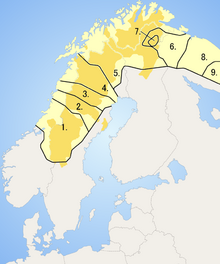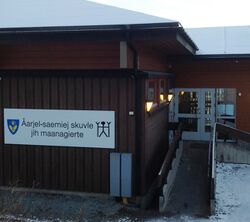Social:Southern Sami language
| Southern Sámi | |
|---|---|
| åarjelsaemien gïele | |
| Region | Norway , Sweden |
Native speakers | (600 cited 1992)[1] |
| Latin | |
| Official status | |
Official language in | Hattfjelldal, Røros, Snåsa and Røyrvik in Norway[2] |
Recognised minority language in | Norway Sweden[3] |
| Language codes | |
| ISO 639-1 | sma |
| ISO 639-3 | sma |
| Glottolog | sout2674[4] |
 Southern Sámi is 1 on this map. | |
Southern or South Sámi (åarjelsaemien gïele) is the southwestern-most of the Sámi languages, and is spoken in Norway and Sweden. It is a seriously endangered language; the strongholds of this language are the municipalities of Snåsa, Røyrvik, Røros and Hattfjelldal in Norway.
It is possible to study Southern Sámi at Nord University in Levanger, Umeå University in Umeå, and Uppsala University in Uppsala. In 2018 there were two master's degrees written in the language at Umeå University.[5] Language courses are also offered in different Sámi language centres throughout the south Sámi area.
Writing system
Southern Sámi is one of the six Sámi languages that has an official written standard, but only a few books have been published for the language, one of which is an adequate-sized Southern Sámi–Norwegian dictionary.
Southern Sámi uses the Latin alphabet:
| A a | B b | D d | E e | F f | G g | H h | I i |
| Ï ï | J j | K k | L l | M m | N n | O o | P p |
| R r | S s | T t | U u | V v | Y y | Æ æ | Ö ö |
| Å å |
The Sámi Language Council recommended in 1976 to use ⟨æ⟩ and ⟨ö⟩, but in practice the latter is replaced by ⟨ø⟩ in Norway and the former by ⟨ä⟩ in Sweden.[6] This is in accordance with the usage in Norwegian and Swedish, based on computer or typewriter availability. The Ï ï represents a back version of I i, however many texts fail to distinguish between the two.
C c, Q q, W w, X x, Z z are only used in words of foreign origin.
Phonology
Southern Sámi has two dialects, the northern and the southern dialect. The phonological differences between the dialects are relatively small; the phonemic system of the northern dialect is explained below.
Vowels
The vowel phonemes of the northern dialect are the following; orthographic counterparts are given in italics:
| front | central | back | ||||
|---|---|---|---|---|---|---|
| unrounded | rounded | unrounded | rounded | unrounded | rounded | |
| close | i ⟨i⟩ | y ⟨y⟩ | ɨ ⟨ï⟩, ⟨i⟩[lower-alpha 1] | ʉ ⟨u⟩ | u ⟨o⟩ | |
| mid | e ⟨e⟩ | o ⟨å⟩ | ||||
| open | ɛ ⟨æ⟩, ⟨ä⟩,[lower-alpha 2] ⟨ae⟩[lower-alpha 3] | ɑ ⟨a⟩ | ||||
- ↑ The distinction between the vowels /i/ and /ɨ/ is normally not indicated in spelling: both of these sounds are written with the letter ⟨i⟩. However, dictionaries and other linguistically precise sources use the character ⟨ï⟩ for the latter vowel.
- ↑ The spelling ⟨æ⟩ is used in Norway, and ⟨ä⟩ in Sweden.
- ↑ Long /ɛː/ is written ⟨ae⟩.
The non-high vowels /e/, /ɛ/, /o/ and /ɑ/ contrast in length: they may occur as both short and long. High vowels only occur as short.
The vowels may combine to form ten different diphthongs:
| front | front to back | central to back | central to front | back to front | back | |
|---|---|---|---|---|---|---|
| close to mid | /ie/ ⟨ie⟩ | /yo/ ⟨yø⟩, ⟨yö⟩ | /ʉe/ ⟨ue⟩; /ɨe/ ⟨ïe⟩, ⟨ie⟩ | /uo/ ⟨oe⟩ | ||
| close to open | /ʉa/ ⟨ua⟩ | |||||
| mid | /oe/ ⟨øø⟩, ⟨öö⟩ | |||||
| mid to open | /eæ/ ⟨ea⟩ | /oæ/ ⟨åe⟩ | /oa/ ⟨åa⟩ |
Consonants
| Labial | Dental | Alveolar | Postalveolar | Palatal | Velar | Glottal | ||
|---|---|---|---|---|---|---|---|---|
| Plosive | unaspirated | p ⟨b⟩, ⟨p⟩ | t ⟨d⟩, ⟨t⟩ | ts ⟨ts⟩ | tʃ ⟨tj⟩ | k ⟨g⟩, ⟨k⟩ | ||
| aspirated | pʰ ⟨p⟩ | tʰ ⟨t⟩ | kʰ ⟨k⟩ | |||||
| Fricative | f ⟨f⟩ | s ⟨s⟩ | ʃ ⟨sj⟩ | h ⟨h⟩ | ||||
| Nasal | m ⟨m⟩ | n ⟨n⟩ | ɲ ⟨nj⟩ | ŋ ⟨ng⟩ | ||||
| Lateral | l ⟨l⟩ | |||||||
| Trill | r ⟨r⟩ | |||||||
| Approximant | β ~ w ⟨v⟩ | j ⟨j⟩ | ||||||
Grammar
Sound alternations
In Southern Sámi, the vowel in the second syllable of a word causes changes to the vowel in the first syllable, a feature called umlaut. The vowel in the second syllable can change depending on the inflectional ending being attached, and the vowel in the first vowel will likewise alternate accordingly. Often there are three different vowels that alternate with each other in the paradigm of a single word, for example as follows:
- ae ~ aa ~ ee: vaedtsedh 'to walk' : vaadtsam 'I walk' : veedtsim 'I walked'
- ue ~ ua ~ öö: vuelkedh 'to leave' : vualkam 'I leave' : vöölkim 'I left'
The following table gives a full overview of the alternations:
| Proto-Samic first vowel |
Followed by *ā |
Followed by *ē |
Followed by *ō |
Followed by *ë |
Followed by *i |
|---|---|---|---|---|---|
| *ā | aa | ae | aa | aa | ee |
| *ea | ea | ie | ea | aa | ee |
| *ie | ea | ie | ea | ïe | ie |
| *oa | åa | åe | åa | oe | öö |
| *uo | ua | ue | åa | oe | öö |
| *ë | a | e | æ, å | a, ï | e |
| *i | æ, ij | i | æ | ïj | i |
| *o | å | u | å, a | o, a, ov | u |
| *u | å, a | u | å | o, ov | u |
On the other hand, Southern Sami is the only Sami language that does not have consonant gradation. Hence consonants in the middle of words never alternate in Southern Sami, even though such alternations are frequent in other Sami languages. Compare, for instance, Southern Sami nomme 'name' : nommesne 'in the name' to Northern Sami namma : namas, with the consonant gradation mm : m.
Cases
Southern Sami has 8 cases:
| Case | Singular ending | Plural ending |
|---|---|---|
| Nominative | - | -h |
| Accusative | -m | -jte / -ite / -idie |
| Genitive | -n | -i / -j |
| Illative | -n / -se / -sse | -jte / -ite / -idie |
| Inessive | -sne / -snie | -ine / -jne / -inie |
| Elative | -ste / -stie | -jste / -jstie |
| Comitative | -ine / -jne / -inie | -igujmie / -jgujmie |
| Essive | -ine / -jne / -inie | (no plural form) |
Verbs
Person
Southern Sámi verbs conjugate for three grammatical persons:
- first person
- second person
- third person
Mood
Tense
Grammatical number
Southern Sámi verbs conjugate for three grammatical numbers:
- singular
- dual
- plural
Negative verb
Southern Sámi, like Finnish, the other Sámi languages, and Estonian, has a negative verb. In Southern Sámi, the negative verb conjugates according to tense (past and non-past), mood (indicative and imperative), person (1st, 2nd and 3rd) and number (singular, dual and plural). This differs from some other Sámi languages, e.g. from Northern Sámi, which do not conjugate according to tense.
| Non-past indicative | Past indicative | |||||
|---|---|---|---|---|---|---|
| Singular | Dual | Plural | Singular | Dual | Plural | |
| 1st | im | ean | ibie | idtjim | idtjimen | idtjimh |
| 2nd | ih | idien | idie | idtjih | idtjiden | idtjidh |
| 3rd | ij | eakan | eah | idtji | idtjigan | idtjin |
| Non-past imperative | Past imperative | |||||
|---|---|---|---|---|---|---|
| Singular | Dual | Plural | Singular | Dual | Plural | |
| 1st | aelliem | aellien | aellebe | ollem | ollen | ollebe |
| 2nd | aellieh | aelleden | aellede | ollh | olleden | ollede |
| 3rd | aellis | aellis | aellis | olles | olles | olles |
Syntax
Like Skolt Sámi and unlike other Sámi languages, Southern Sámi is an SOV language.
References
- ↑ Southern Sámi at Ethnologue (18th ed., 2015)
- ↑ "Samelovens språkregler og forvaltningsområdet for samisk språk" (in Norwegian). Statsministerens kontor. 2014-08-12. https://www.regjeringen.no/no/tema/urfolk-og-minoriteter/samepolitikk/samiske-sprak/samelovens-sprakregler-og-forvaltningsom/id633281/. "Forvaltningsområdet for samisk språk omfatter [...] Snåasen tjïelte/Snåsa kommune og Raarvihke Tjielte/Røyrvik kommune i Nord-Trøndelag."
- ↑ "To which languages does the Charter apply?". European Charter for Regional or Minority Languages. Council of Europe. p. 5. http://hub.coe.int/c/document_library/get_file?uuid=d74fc9bd-0c0c-40ac-9e47-26d4887daf8e&groupId=10227. Retrieved 2014-04-03.
- ↑ Hammarström, Harald; Forkel, Robert; Haspelmath, Martin, eds (2017). "South Saami". Glottolog 3.0. Jena, Germany: Max Planck Institute for the Science of Human History. http://glottolog.org/resource/languoid/id/sout2674.
- ↑ "Umeå University". http://umu.diva-portal.org/smash/resultList.jsf?dswid=-8946&language=en&searchType=SIMPLE&query=2018+%28Sami+languages+%28Other%29%29&af=%5B%5D&aq=%5B%5B%5D%5D&aq2=%5B%5B%5D%5D&aqe=%5B%5D&noOfRows=50&sortOrder=author_sort_asc&sortOrder2=title_sort_asc&onlyFullText=false&sf=all. Retrieved 2019-07-06.
- ↑ Magga, Ole Henrik; Magga, Lajla Mattsson (2012) (in Norwegian). Sørsamisk grammatikk. Kautokeino: Davvi Girji. p. 12. ISBN 978-82-7374-855-3.
- Bergsland, Knut. Røroslappisk grammatikk, 1946.
- Knut Bergsland. Sydsamisk grammatikk, 1982.
- Knut Bergsland and Lajla Mattson Magga. Åarjelsaemien-daaroen baakoegærja, 1993.
- Hasselbrink, Gustav. Südsamisches Wörterbuch I–III
External links
| Southern Sami language test of Wikipedia at Wikimedia Incubator |
- The Children's TV series Binnabánnaš in Southern Sámi
- Sámi lottit Names of birds found in Sápmi in a number of languages, including Skolt Sámi and English. Search function only works with Finnish input though.
- Southern Sámi grammatical resources
- Samien Sijte – Southern Sámi Museum and Cultural Center
- Sørsamisk forskning og undervisning[yes|permanent dead link|dead link}}] – Universitetet i Tromsø


